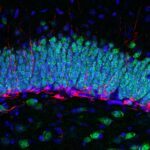In: Cutsuridis V., Graham B., Cobb S., Vida I. (eds) Hippocampal Microcircuits. Springer Series in Computational Neuroscience (2018). Springer, Cham
Grid cells in the medial entorhinal cortex (mEC) fire whenever the animal enters a regular triangular array of locations that cover its environment. Since their discovery, several models that can account for these remarkably regular spatial firing patterns have been proposed. These generally fall into one of three classes, generating grid cell firing patterns either by oscillatory interference, through continuous attractor dynamics, or as a result of spatially modulated input from a place cell population. Neural network simulations have been used to explore the implications and predictions made by each class of model, while subsequent experimental data have allowed their architecture to be refined. Here, we describe implementations of two classes of grid cell model – oscillatory interference and continuous attractor dynamics – alongside a hybrid model that incorporates the principal features of each. These models are intended to be both parsimonious and make testable predictions. We discuss the strengths and weaknesses of each model and the predictions they make for future experimental manipulations of the grid cell network in vivo.


